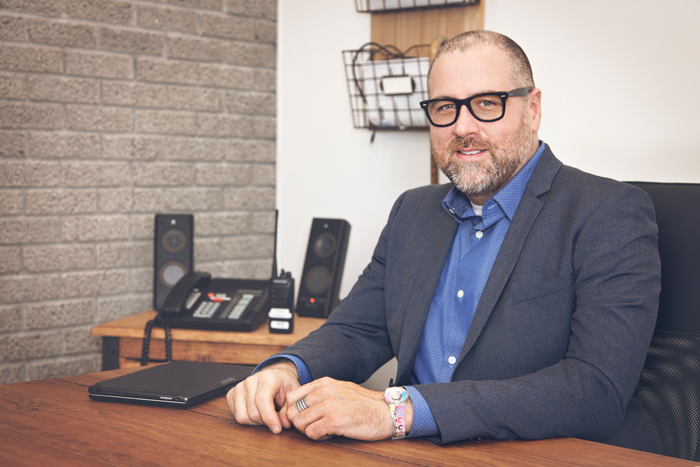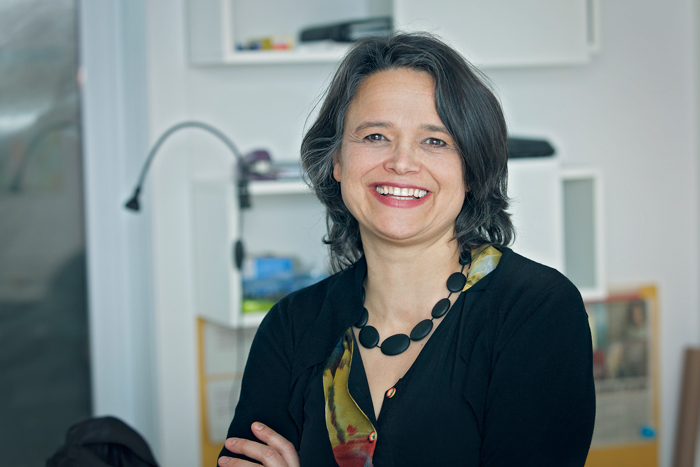Encouraging girls to stay in school by helping them develop a positive self-image and explore their educational and professional aspirations.
Related pages
- A partnership to promote early childhood literacy
- Filling bellies to keep kids in school
- Literacy project creates magical moments for students
- Supporting students who re-engage with school
- Understanding youth to smooth their transition to high school
- When schools and the business sector work together, youth benefit
- Words that resonate for a school and its community
The La créativité en action! program at Montréal’s Antoine-de-Saint-Exupéry high school
Strong communities working to keep girls in school
At Antoine-de-Saint-Exupéry high school in Montréal’s Saint-Léonard neighbourhood, students have access to no fewer than a dozen programs developed by the community sector, under the leadership of assistant principal Martin Sigouin.
“The administration here decided to form beneficial partnerships with the community to stimulate the daily lives of our students. And it works! On Tuesday evenings, I have 100 students in the school taking part in social, environmental, culinary, or artistic activities, all overseen by different organizations, each of which contributes its own flavor to our school.”
 Martin Sigouin, assistant principal, Antoine-de-Saint-Exupéry high school
Martin Sigouin, assistant principal, Antoine-de-Saint-Exupéry high school
(Photo: François Couture)
When, in this spirit of developing productive partnerships, Sigouin attended a presentation by Isabel Serra, founder of Naos jeunesse, he immediately understood that it could help with one of the school’s concerns – ensuring that troubled girls do not drop out and fall into delinquency, a growing trend in a borough where many families grapple with poverty.
The invisible problem of girls dropping out
Though the public is largely unaware of it, the research data is clear: girls drop out for very different reasons than boys. This is also what Isabel Serra sees on the ground.
“Girls at risk of dropping out are not usually disruptive in class; in fact, they tend to be shy and often slip between the cracks.”
“For girls, dropping out is often related to an unseen personal problem, so it’s much harder to spot. Girls at risk of dropping out are not usually disruptive in class; in fact, they tend to be shy and often slip between the cracks. I started Naos Jeunesse in 2014 to help these girls break out of their isolation, stand up for themselves, and build healthy relationships with their peers, whether it be through creativity, games, or sports,” explains Serra, herself a former dropout who has practiced law for 20 years.
 Isabel Serra, founder of Naos jeunesse
Isabel Serra, founder of Naos jeunesse
(Photo: François Couture)
Offered to girls 10 to 17 years old, the La créativité en action program encourages girls to stay in school by helping them develop a positive self-image and explore their educational and professional aspirations. Program participants take part in a series of 10 workshops given during the lunch hour in schools and after class in community organizations.
Partner engagement and leadership – conditions of success for community programs in schools
Sigouin suggested that Serra start an pilot project to encourage girls at Antoine-de-Saint-Exupéry to stay in school. The program was an immediate success. The girls got on board and, since 2015, La créativité en action has been firmly established at the school.
And thanks to the powerful model employed by Sigouin and Serra’s openness, Naos Jeunesse has been able to adapt to local conditions to even better meet the girls’ needs.
“I’m convinced that for a community program to succeed in a school, everyone involved must be rooted in the community the program serves. My role is to act as a force multiplier and networker…”
“I’m convinced that for a community program to succeed in a school, everyone involved must be rooted in the community the program serves. My role is to act as a force multiplier and networker; I introduced Isabel to many local stakeholders, such as Collectif Jeunesse Saint-Léonard and the directors of organizations our girls attend. This allowed her to see how the program might better match the realities and needs of our community.”
Sigouin also feels that the success of these partnerships depends greatly on educational stakeholders working closely with the community organizations offering the programs. “It’s very important that a member of our staff accompanies the students in each of the community-run activities offered in the school so that they gain a sense of ownership of the programs, provide moral support as it were, and better monitor the situation if a major problem should arise, such as bullying, violence at home, or malnutrition,” explains Sigouin.
Naos Jeunesse has become a kind of transmission belt between the girls, the school, and the community, greatly tightening the mesh of the local social safety net.
“They told us they needed us, and we are so happy that we can play a meaningful role there. But it could never have happened without the school’s help…”
“The model has been so effective, we hope to reproduce it elsewhere,” notes Serra. “A sports association in Saint-Léonard, Gestion Multisports, told us that girls were almost absent from local gyms. So we took our groups of NJCA girls, had them pick a sport of their choice, and they were able to have a coach and a gym to themselves. The Bureau Associatif pour la Diversité et la Réinsertion was looking for activities to integrate their young girls, and we were able to provide that. Being able to work in concert with local stakeholders is so valuable! They told us they needed us, and we are so happy that we can play a meaningful role there. But it could never have happened without the school’s help and the vision of Martin Sigouin.”
_ January, 2018
 Réseau réussite Montréal is continuing its series of feature articles on fruitful collaborations between the education sector and community partners that foster the success of youth.
Réseau réussite Montréal is continuing its series of feature articles on fruitful collaborations between the education sector and community partners that foster the success of youth.
We asked journalist and photographer François Couture to go and meet the people involved in these partnerships and tell their stories.




